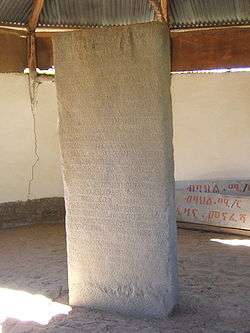Ezana Stone

The Ezana stone is an artifact from the ancient Kingdom of Aksum. It is a stone monument which documents the conversion of King Ezana to Christianity and his subjugation of various neighboring areas, including Meroë.
From AD 330 to 356, King Ezana ruled the ancient Kingdom of Aksum centered in the Horn of Africa. He fought against the Nubians, and commemorated his victories on stone tablets written in Ge'ez (the ancient Eritrean/Ethiopian language), Sabaean (South Arabian) and Greek in praise of God. His carvings in stone provided a trilingual monument in different languages, similar to the Rosetta stone.
The Ethiopian Orthodox Tewahedo Church had its beginnings during this period. Rufinus's Ecclesiastical History narrates that Saint Frumentius, a slave and tutor for the very young King, converted him to Christianity. Towards the end of his reign, King Ezana launched a campaign against the Kushites around 350 which brought down the Kingdom of Kush. Various stone inscriptions written in Ge'ez (using the Ge'ez script) have been found at Meroë, the central city of the Kushites.
See also
References
External links
- National Geographic article
- Harden, J. M., "An introduction to Ethiopic Christian Literature" (1926) Chapter II, "Brief Historical Sketch of the Country and Church", contains a discussion of this inscription
Coordinates: 14°7′26.8″N 38°43′30.6″E / 14.124111°N 38.725167°E